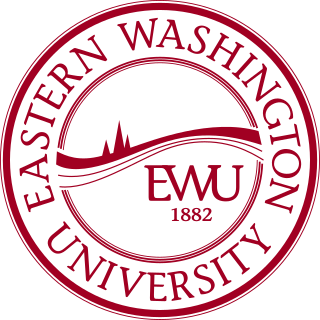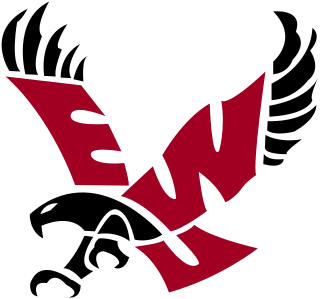
The Nineteenth Amendment to the United States Constitution prohibits the United States and its states from denying the right to vote to citizens of the United States on the basis of sex, in effect recognising the right of women to a vote. The amendment was the culmination of a decades-long movement for women's suffrage in the United States, at both the state and national levels, and was part of the worldwide movement towards women's suffrage and part of the wider women's rights movement. The first women's suffrage amendment was introduced in Congress in 1878. However, a suffrage amendment did not pass the House of Representatives until May 21, 1919, which was quickly followed by the Senate, on June 4, 1919. It was then submitted to the states for ratification, achieving the requisite 36 ratifications to secure adoption, and thereby go into effect, on August 18, 1920. The Nineteenth Amendment's adoption was certified on August 26, 1920.

Cheney is a city in Spokane County, Washington, United States. The full-time resident population was 10,590 as of 2010 census. Eastern Washington University is located in Cheney. When classes are in session at EWU, the city's population reaches approximately 17,600 people on a temporary basis.

Eastern Washington University is a public university in Cheney, Washington. It also offers programs at a campus in EWU Spokane at the Riverpoint Campus and other campus locations throughout the state.

The League of Women Voters (LWV) is a nonprofit organization in the United States that was formed to help women take a larger role in public affairs after they won the right to vote. It was founded in 1920 to support the new women suffrage rights and was a merger of National Council of Women Voters, founded by Emma Smith DeVoe, and National American Woman Suffrage Association, led by Carrie Chapman Catt, approximately six months before the Nineteenth Amendment to the United States Constitution gave women the right to vote. The League of Women Voters began as a "mighty political experiment" aimed to help newly enfranchised women exercise their responsibilities as voters. Originally, only women could join the league; but in 1973 the charter was modified to include men. LWV operates at the local, state, and national level, with over 1,000 local and 50 state leagues, and one territory league in the U.S. Virgin Islands. The league states that it has over 500,000 members and supporters.

The first modern Farmer–Labor Party in the United States emerged in Minnesota in 1918. Economic dislocation caused by American entry into World War I put agricultural prices and workers' wages into imbalance with rapidly escalating retail prices during the war years, and farmers and workers sought to make common cause in the political sphere to redress their grievances.

Carrie Chapman Catt was an American women's suffrage leader who campaigned for the Nineteenth Amendment to the United States Constitution, which gave US women the right to vote in 1920. Catt served as president of the National American Woman Suffrage Association from 1900 to 1904 and 1915 to 1920. She founded the League of Women Voters in 1920 and the International Woman Suffrage Alliance in 1904, which was later named International Alliance of Women. She "led an army of voteless women in 1919 to pressure Congress to pass the constitutional amendment giving them the right to vote and convinced state legislatures to ratify it in 1920" and "was one of the best-known women in the United States in the first half of the twentieth century and was on all lists of famous American women."

Cheney School District No. 360 is a public school district in Spokane County, Washington and serves the towns of Cheney, Airway Heights, and the surrounding area. The district offers classes from Kindergarten to Grade 12.

Harriet Taylor Upton was an American political activist and author. Upton is best remembered as a leading Ohio state and national figure in the struggle for women's right to vote and as the first woman to become a vice-chairman of the Republican National Committee.

The Eastern Washington Eagles are the intercollegiate varsity athletic teams of Eastern Washington University in Cheney, southwest of Spokane. A member of the Big Sky Conference, EWU's athletic program comprises five men's sports: basketball, cross country, football, tennis, and track and field, and seven women's sports: basketball, cross country, golf, soccer, tennis, track and field, and volleyball.

The United States Senate is the upper chamber of the United States Congress, with the House of Representatives being the lower chamber. Together they compose the national bicameral legislature of the United States.

The League of Nations was established with three main constitutional organs: the Assembly; the Council; the Permanent Secretariat. The two essential wings of the League were the Permanent Court of International Justice and the International Labour Organization.
The Eastern Washington Eagles football team represents Eastern Washington University in the NCAA Division I Football Championship Subdivision. The Eastern Eagles are members of the Big Sky Conference and play at Roos Field, which is known for being the only stadium in college football with a red playing surface.
This timeline highlights milestones in women's suffrage in the United States, particularly the right of women to vote in elections at federal and state levels.
African Americans are among the largest ethnic groups in the state of Tennessee, making up 17% of the state's population in 2010. African Americans arrived in the region prior to statehood. They lived both as slaves and as free citizens with restricted rights up to the Civil War. The state, and particularly the major cities of Memphis and Nashville have played important roles in African-American culture and the Civil Rights Movement. The majority of African Americans in Tennessee reside in the western part of the state, with much smaller Black populations in the central and eastern (Appalachian) regions of the state.

William James Sutton was an American politician in the state of Washington. He served in the Washington State Senate from 1913 to 1917 and 1921 to 1933. From 1931 to 1933, he was President pro tempore of the Senate.
William Bryan "Red" Reese was athletic director and coach of multiple sports at Eastern Washington University in Cheney from 1930 to 1964.
The 1891 State Normal School at Cheney fire was a conflagration on the morning of August 27, 1891, that consumed the only building then housing the State Normal School at Cheney in Cheney, Washington. No lives were lost, but the destruction of the building sparked a multi-year battle with the governor and state legislature regarding whether the normal school would be shuttered, or whether the state would authorize funds for the construction of a replacement building.
Mary Ann Monroe was a prominent teacher and school administrator in Spokane, Washington, and an active figure in education across the state of Washington. She was the first woman to serve as president of the Washington Education Association and the first woman on the board of trustees at the State Normal School at Cheney. She ran unsuccessfully for the office of Washington Superintendent of Public Instruction in 1912, but was active in civic and state politics in the early 20th century.
The Women's and Gender Education Center at Eastern Washington University was established in 1977 as the EWU Women's Center, and has continued to serve students at EWU since that time. The center is part of the Women's and Gender Studies Program.

Women's suffrage in Virginia was granted in 1920, with the ratification of the Nineteenth Amendment. The General Assembly, Virginia's governing legislative body, did not ratify the Nineteenth Amendment until 1952. The argument for women's suffrage in Virginia began in 1870, but it did not gain traction until 1909 with the founding of the Equal Suffrage League of Virginia. Between 1912 and 1916, Virginia's suffragists would bring the issue of women's voting rights to the floor of the General Assembly three times, petitioning for an amendment to the state constitution giving women the right to vote; they were defeated each time. During this period, the Equal Suffrage League of Virginia and its fellow Virginia suffragists fought against a strong anti-suffragist movement that tapped into conservative, post-Civil War values on the role of women, as well as racial fears. After achieving suffrage in August 1920, over 13,000 women registered within one month to vote for the first time in the 1920 United States presidential election.












